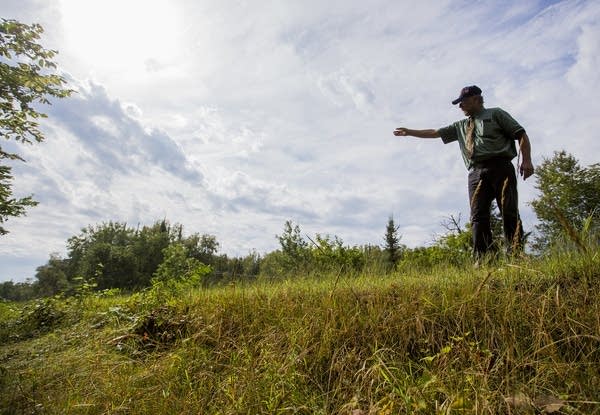Ely highway reroute bogged down by safety, environmental concerns
Go Deeper.
Create an account or log in to save stories.
Like this?
Thanks for liking this story! We have added it to a list of your favorite stories.

Anyone who has driven along Highway 169 in northeast Minnesota knows that in one crucial section it twists through lakes and thick pine forest.
"It's a beautiful road, but dangerous," St. Louis County Commissioner Mike Forsman said on a recent drive. "Look at the steep ravine right here, if you notice, all these steep ravines, there are no guard rails on them."
Beyond narrow shoulders that are just a couple feet wide, the terrain plummets about 20 feet.
A long-awaited highway safety project by the Minnesota Department of Transportation to improve Highway 169 could make the road safer for drivers. But it has been slowed by environmental concerns -- the same type of concerns that are dogging proposed copper nickel mines in the region.
Turn Up Your Support
MPR News helps you turn down the noise and build shared understanding. Turn up your support for this public resource and keep trusted journalism accessible to all.
At issue is potential water pollution along a stretch of road between Ely and the Iron Range. But instead of pitting proponents of mining jobs against those concerned about pollution, the latest debate is shaping up as choice between safety and the environment.

Forsman has worked for more than a decade to make the five-mile section of road safer with less severe slopes, wider shoulders and passing lanes. He's seen a lot of accidents on the highway, and been in his share too.
So has Bill Erzar, who chairs the Trunk Highway 169 North Improvement Task Force pushing the highway realignment. He recalls one treacherous drive to work when the car he was riding in spun out and collided with a truck.
"We got hit; the whole passenger side got caved in," Erzar said. "The glass come flying through there like a bunch of bullets. It's scary."
Local advocates say that would make the straightest and safest road by reducing the black ice that makes the corners treacherous in winter.
Forsman and Erzar have a story seemingly for every twist in the road. The Pizza Hut truck driver killed when his semi careened into a ditch. The young mother killed after spinning out on black ice.
"The people that died on this road, to MnDot, they're just a number, they're a statistic," Erzar said. "Many of those people, in fact most of them, Mike and I knew."

In 2005 the task force helped secure nearly $18 million in federal funding for the project. State transportation officials, who has analyzed more than a dozen alternatives, eventually backed a realignment the task force is pushing that would move the highway about a quarter mile to the south.
But officials with the state Department of Natural Resources and the federal Environmental Protection Agency raised concerns about the route, in part because it would require blasting about half a million tons of rock that is high in sulfur. When that sulfide-bearing rock is exposed to air and water, it creates sulfuric acid, which if not properly managed, can leach heavy metals into nearby waterways.
That's the same basic chemistry underlying much of the opposition to copper nickel mining in the region.
"Our concerns are water quality," said Terry Anderson, one of several landowners on nearby Six Mile Lake and Lake Vermillion who oppose the reroute. "I think the right thing to do is not choose this environmentally dangerous route."
In response, MnDOT came back with a plan that would leave the road along its existing corridor, but address many of the current safety concerns, like steep slopes and narrow shoulders.
"Our initial thought is it would have less wetland impacts, less rock excavation, less cost," said Michael Kalnbach, who is managing the project for MnDOT.

But the plan, which wouldn't eliminate all of the curves, received a cool reception when Kalnbach presented it in Ely earlier this year.
"I think Bill Erzar tells it, there were about 70 people there, and 68 of them were not in favor of what MnDOT was calling our preferred alternative," Kalnbach said.
MnDOT relented and agreed to reconsider the south route backed by the local task force.
That's frustrating Anderson, who just finished building a small cabin on Six Mile Lake.
"We're sort of scratching our heads, because there is a proposal out there that according to MnDOT is equally safe, will cost five million dollars less, and will not run into the same level of environmental impact," Anderson said. "So we're wondering what's driving this pressure to use this route."
Part of the pressure has come from politicians, including U.S. Rep. Rick Nolan, a Democrat who represents the 8th District. He said concerns about potential pollution are genuine but they can be managed.
"There are ways to remove rock that are environmentally safe and can remove the potential for any kind of pollution," Nolan said.
MnDOT has drawn up a compromise alternative that would keep the highway in its existing corridor, but straighten out more of the dangerous curves. It also would not require a detour, something area residents had strongly opposed.
Transportation officials plan to have the proposal ready for public comment early next year.
Editor's note: An earlier version of this story incorrectly stated the number of tons of rock that would need to be blasted to build the road. It has been updated with the correct number.




